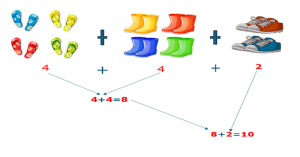2 Associative Property of Addition
Anonymous
Associative Property of Addition
Formal definition: associative property is defined as, when more than two numbers are added or multiplied, the result remains the same, irrespective of how they are grouped. (Definition from: Splash learn)
Kid-friendly explanation: To “associate” means to connect or join with something. According to the associative property of addition the sum of three or more numbers remains the same regardless of how the numbers are grouped. The associative property of addition enables you to change the places of the numbers, to group them together and at the same time to be sure their sum or answer remains unchanged.
Example: Let’s say your mom has 4 pairs of sandals, 4 pairs of boots, and 2 pairs of sneakers. The question is, how many pairs of shoes does your mom have in total?
To answer this question, first I can add the 4 pairs of sandals and the 4 pairs of boots. Then, I will add the 2 pairs of sneakers remaining.

Or you can start by adding 4+2=6 and then add 4 to the 6 that equals 10 as well. Here, we applied the associate property of addition by changing the groups order and getting the same result.

|

